Gravitational Force Calculator
Use this gravitational force calculator to see how objects, big and small, attract to one another with gravity.
Welcome to my exploration of one of the universe's most profound and ubiquitous forces: gravity. This fundamental force is the invisible hand sculpting the architecture of the cosmos, from the fall of an apple to the dance of galaxies. It's a force that permeates our everyday lives, yet it took the genius of Sir Isaac Newton to recognize and quantify its influence on the physical objects around us.
Newton's Law of Universal Gravitation was revolutionary. It provided us with the first mathematical framework for understanding how objects attract each other with a force that is directly proportional to their masses and inversely proportional to the square of the distance between their centers. This was a monumental leap for 17th-century science and remained the cornerstone of our understanding of gravitational phenomena for nearly three centuries.
However, the story of gravity didn't end with Newton. At the dawn of the 20th century, Albert Einstein reshaped our understanding of gravity through his General Theory of Relativity. Einstein proposed that gravity is not just a force but the curvature of spacetime itself, caused by the presence of mass and energy. This perspective has since passed rigorous tests—from the bending of light to the precise orbits of the planets—and continues to inform our understanding of the cosmos.
To bridge the gap between the abstract concept of gravity and tangible experience, I've embedded the above gravitational force calculator. Whether you're a student, educator, hobbyist, or just plain curious, this calculator offers a hands-on approach to understanding the dynamics of gravity. It's a demonstration of how the laws that govern the motion of planets and stars also apply to the objects in our daily lives.
Let's embark on this gravitational journey together. Feel the pull of curiosity? Start experimenting with the calculator that ties together the celestial and the terrestrial, and discover the cosmic ballet that's been choreographed by gravity.
Section 2: Fun and Educational Examples
Engaging with the concept of gravity doesn't have to be a purely academic endeavor—it can be a playful and enlightening experience too. To illustrate the versatility of the gravitational force calculator, let's dive into some examples that range from the vast expanse of our solar system to the more familiar confines of our surroundings.
Celestial Pairings
The cosmos is a grand stage for the gravitational dance between celestial bodies. The calculator can help us comprehend the immense forces at play. Below is Table 1, where I've calculated the gravitational force between various celestial pairings:
|
Pairing |
Mass 1 |
Mass 2 |
Distance |
Answer |
|---|---|---|---|---|
|
Earth and Moon |
1 Earth |
0.0123 Earths |
60 Earth Radii |
200,370,011 TN |
|
Sun and Jupiter |
1 Sun |
317.8 Earths |
420,000 Earth Radii |
35,188,471,919 TN |
|
Earth and Sun |
1 Earth |
1 Sun |
1 AU |
35,423,960,813 TN |
|
Sun and Mercury |
1 Sun |
0.055 Earths |
170,000 Earth Radii |
37,171,487 TN |
Table 1: The gravitational force between various celestial bodies calculated using the average mass and distance of each pairing.
For the actual force values, you can input the data from the table into the calculator and watch the cosmic choreography unfold in numbers.
Everyday Objects
Moving from the cosmic scale to our daily surroundings, the gravitational attraction exists even between everyday objects, albeit with much smaller forces. In Table 2, you'll find the gravitational forces between common objects that we see around us:
|
Objects |
Mass 1 (kg) |
Mass 2 (kg) |
Distance (m) |
Answer |
|---|---|---|---|---|
|
Car and Bicycle |
1,000 |
10 |
1 |
0.000001 Newtons (N) |
|
Dog and House |
40 |
100,000 |
10 |
0.000003 Newtons (N) |
Table 2: The gravitational force between common objects, demonstrating that gravity acts on all scales.
To find the exact force, simply use the figures provided and calculate them with our gravitational force calculator. While these forces are too small to feel, they're a wonderful reminder that the same principles that keep the Moon in orbit around Earth also apply to the car and bicycle resting in your driveway.
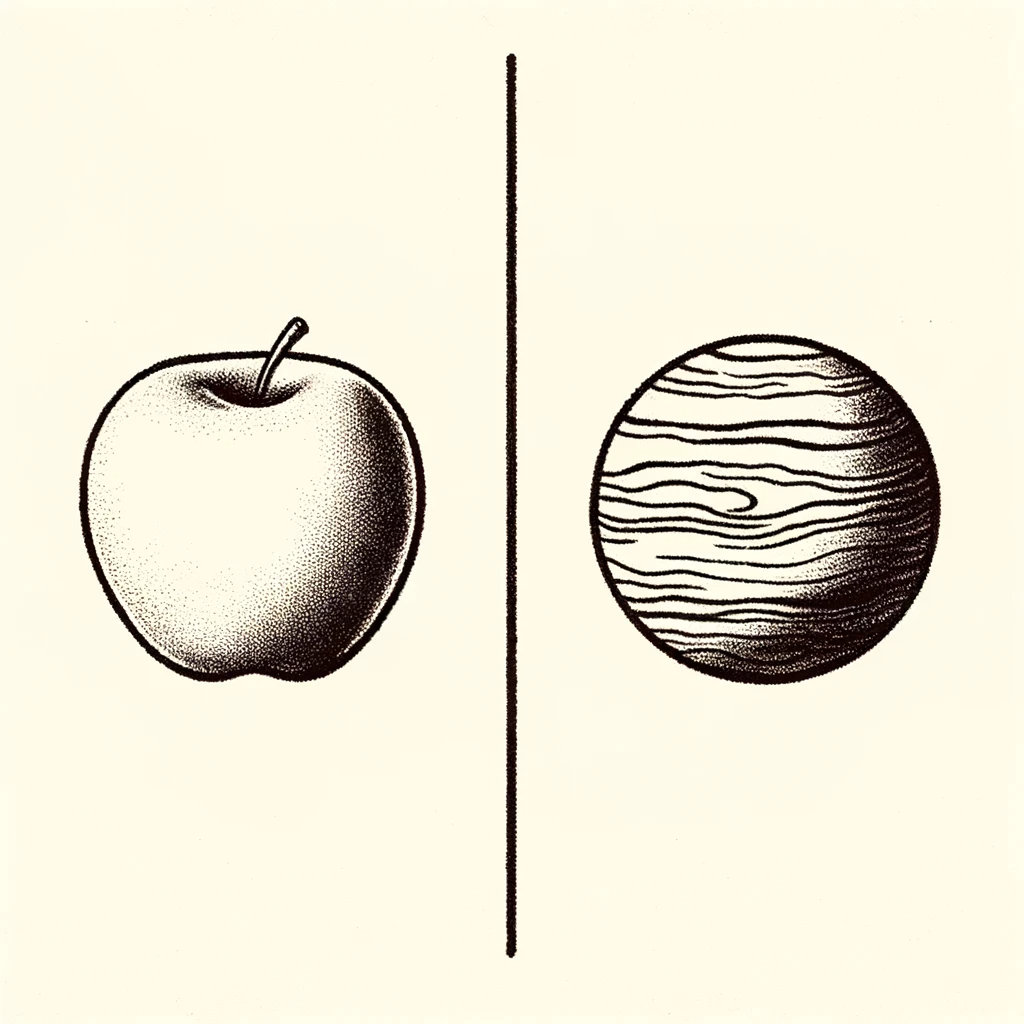
The calculations provided in these tables offer just a glimpse into the gravity's reach. From the grand cosmic ballet to the tiniest tug between a pet and its home, gravity is the silent composer of this universal symphony.
Section 3: Newton's Law of Universal Gravitation
In the 17th century, Sir Isaac Newton revolutionized our understanding of the universe with his Law of Universal Gravitation. This was a time of immense scientific ferment, where the mysteries of the cosmos were being unraveled using the light of reason and the tools of mathematics. Newton's insight laid the groundwork for celestial mechanics, enabling us to predict the motion of planets and moons with astonishing precision.
Newton postulated that every particle of matter in the universe attracts every other particle with a force that is directly proportional to the product of their masses and inversely proportional to the square of the distance between their centers. This force of attraction is what we understand as gravity.
The formula that encapsulates this law is elegantly simple yet profoundly far-reaching:
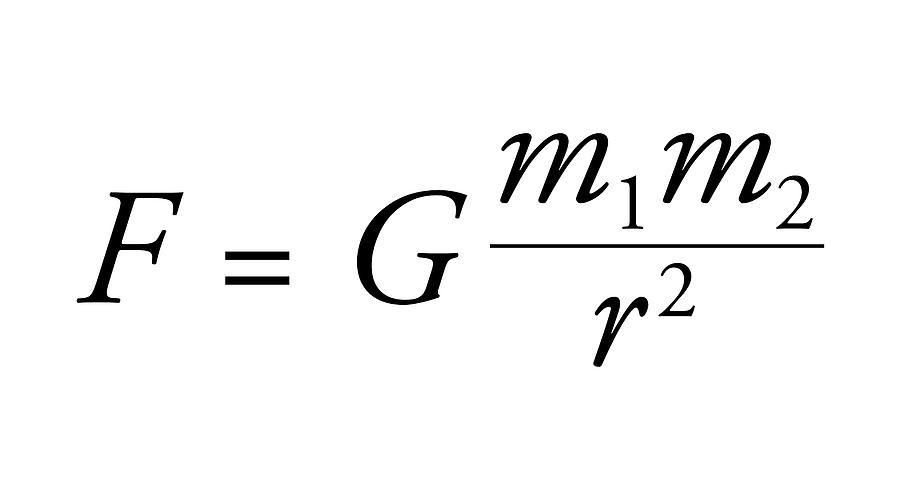
Here, F is the gravitational force between two masses, G is the gravitational constant, m1 and m2 are the masses of the objects, and r is the distance between the centers of the two masses.
This formula tells us that the gravitational force:
- Increases with greater mass of the objects involved.
- Decreases as the distance between the objects increases.
- Is universal—applying to apples and oranges on Earth as well as to planets and stars in the heavens.
Newton’s law showed us that the same physical principles that guide the falling of an apple are also responsible for the orbits of the planets. This universality was a profound revelation, suggesting a cosmos interconnected by laws that could be understood and described mathematically.
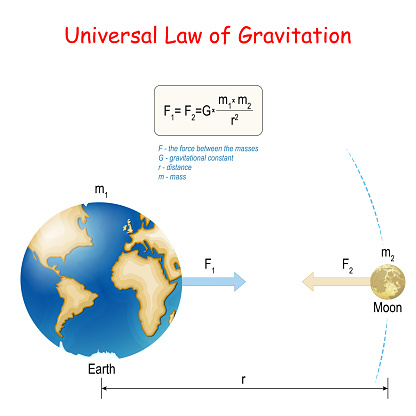
Diagram of Newton’s Law of Universal Gravitation
Newton's Law of Universal Gravitation is a cornerstone of classical physics. It's a testament to the power of human curiosity and intellect, and it remains one of the greatest scientific discoveries in history.
Section 4: Einstein's General Theory of Relativity
While Newton's law provided a robust framework for understanding gravitational phenomena for centuries, it was Albert Einstein who, in the early 20th century, delved deeper into the fabric of reality to reformulate the nature of gravity. His General Theory of Relativity, published in 1915, redefined gravity not as a force, but as a consequence of the curvature of spacetime caused by mass and energy.
Einstein proposed that what we perceive as the force of gravity is actually the motion of objects following the straightest path in a curved spacetime. This curvature is like a trampoline stretched by a heavy object; other objects placed on it will naturally roll towards the heavier object not because of a force between them, but because of the shape of the surface.
This perspective departs radically from the Newtonian view by describing gravity as a geometric property of space and time. According to Einstein, mass and energy tell spacetime how to curve, and spacetime tells objects how to move.
The equations of General Relativity are complex, but the idea can be visualized with the following thought experiment: imagine the Sun as a massive bowling ball placed in the center of a trampoline. The Sun's mass causes the trampoline to warp, creating a 'dent' around it. Now, if we place a smaller ball, say Earth, on this trampoline, it will roll around the Sun, trying to move in a straight line but instead following the curve created by the Sun. This is similar to how planets orbit around the Sun in our solar system.
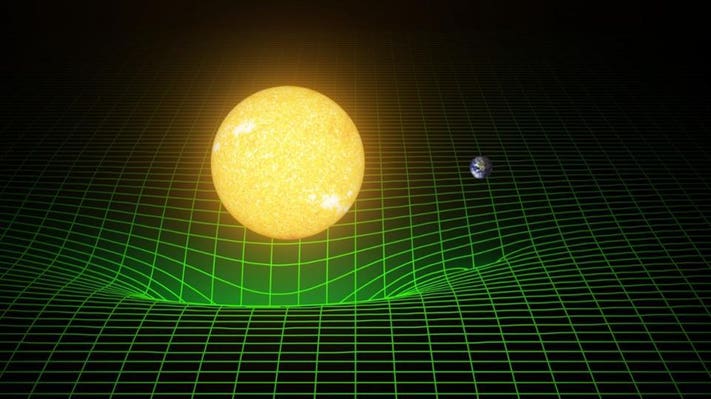
Graphic of Spacetime Curvature
Einstein's theory has been confirmed by numerous experiments and observations. It has provided predictions such as the bending of light around massive objects (gravitational lensing), the precise orbit of Mercury, and the recently observed gravitational waves—ripples in the fabric of spacetime itself.
General Relativity has not only advanced our understanding of gravity but also opened new vistas into the study of black holes, the evolution of the universe, and the conditions during the Big Bang. It remains one of the most successful theories in physics.
Section 5: Gravitational Force in Our Universe
Gravity is the grand conductor of the cosmos, silently shaping the vast and majestic tapestry of the universe. It is the force that forms galaxies and guides their rotation, that coalesces matter into stars and planets, and that influences the path of everything from comets to spacecraft. Without gravity, the universe as we know it would simply not exist.
In the celestial realm, gravity is the force that keeps planets in orbit around stars and moons in orbit around planets. It governs the tides on Earth, the formation of black holes, and the mergers of galaxies. It is also the force behind some of the most spectacular cosmic events, such as supernovae and neutron star collisions, which send gravitational waves rippling through spacetime.
Despite its universal presence, gravity is still not fully understood. Anomalies such as the rotation rates of galaxies and the movements of stars hint at phenomena like dark matter and dark energy—concepts that challenge and extend our current theories. Researchers around the world are actively studying these gravitational mysteries, seeking to uncover the hidden structure and dynamics of our universe.
As we consider the large-scale effects of gravity, it is interesting to compare the predictions made by Newtonian gravity and Einstein's General Relativity. In many everyday scenarios, both theories provide the same predictions; however, at extreme scales—such as near massive stars or in the early universe—the predictions diverge significantly.
Below is a table that outlines how Newtonian and Einsteinian gravity compare in different cosmic scenarios:
|
Scenario |
Newtonian Prediction |
Einsteinian Prediction |
Observed Reality |
|---|---|---|---|
|
Orbit of Mercury |
Slight precession |
Precise precession |
Matches Einsteinian Prediction |
|
Bending of Light by the Sun |
No bending |
Light bends |
Matches Einsteinian Prediction |
|
Expansion of the Universe |
Should slow down |
Can accelerate |
Observed to accelerate |
|
Time Dilation near Massive Objects |
Time is absolute |
Time slows down |
Time dilation observed |
|
Gravitational Waves |
Not predicted |
Predicted |
Directly observed |
Table 3: Comparison of Newtonian and Einsteinian Gravity Predictions
This table reveals the extraordinary precision and foresight of Einstein's theory, especially when it comes to extreme gravitational conditions. From the peculiar orbit of Mercury to the stretching of time near a black hole, General Relativity has provided a more accurate description of our universe.
In conclusion, the story of gravity is still being written. With every new observation and theory, we peel back another layer of this cosmic force, deepening our understanding of the universe and our place within it.
Section 6: Applying the Calculator to Real-World Problems
The gravitational force calculator on my website is more than just an educational tool; it mirrors the types of calculations that scientists and engineers use in various fields of research and industry. Understanding the gravitational force between objects is fundamental to solving real-world problems and advancing our technological capabilities.
In the field of aerospace engineering, for example, precise calculations of gravitational forces are critical. When plotting the course of a spacecraft, mission planners must account for the gravitational pull of celestial bodies. This is essential for maneuvers such as gravity assists, where a spacecraft uses a planet's gravity to gain speed or alter its trajectory—a technique that conserves fuel and is a staple in interplanetary travel.
Gravitational calculations also play a pivotal role in placing satellites into orbit. Engineers calculate the necessary velocity and altitude to achieve a stable orbit around Earth, taking into account the gravitational pull that varies with altitude above the Earth's surface. These calculations ensure that satellites maintain their orbits and don't drift off into space or fall back to Earth.
Another area where gravity calculations are utilized is in the study of climate and ocean patterns. Satellites such as GRACE (Gravity Recovery and Climate Experiment) measure minute changes in Earth's gravity field, which can indicate changes in mass distribution due to melting ice, aquifer depletion, and sea level rise. Such data is crucial for understanding and responding to climate change.
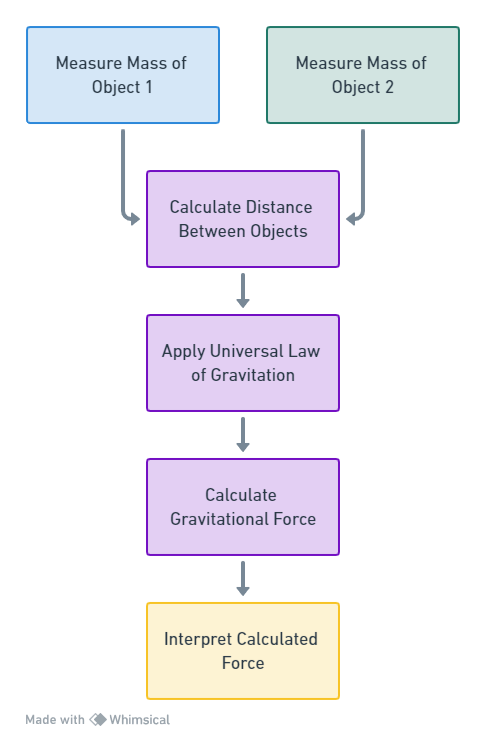
Flowchart of Gravitational Calculations in Practical Applications
The applications of gravity calculations extend beyond these examples, influencing areas such as urban planning, where the gravitational pull of the Earth can affect the structural integrity of buildings and bridges. Even in the realm of personal electronics, gravity sensors help your smartphone's screen rotate and are instrumental in navigation systems.
In essence, the same gravitational principles that govern the motion of planets and stars are also at work in a multitude of earthly technologies and scientific inquiries. By using this calculator, we gain a deeper appreciation for the universal laws of physics and their profound implications across various aspects of our daily lives and the world at large.
Conclusion
Our journey through the realms of gravity, from Newton's apple to the curvature of spacetime, highlights the profound role this fundamental force plays in shaping our universe. Understanding gravity is not just an academic pursuit; it's a window into the mechanics of the cosmos and a tool for solving real-world problems.
I encourage you to use the gravitational force calculator embedded in this article. Experiment with different masses and distances—be they celestial or terrestrial—and observe the resulting forces. This hands-on experience is invaluable in transforming abstract concepts into tangible realities, deepening your appreciation and understanding of the gravitational forces that bind the universe together.
As we continue to explore and understand gravity, we unlock more of the universe's secrets. Every calculation is a step towards a greater understanding, each discovery a testament to human curiosity and ingenuity.
References
For those interested in delving deeper into the topic of gravity, here are some valuable resources:
- Books:
- "The Principia: Mathematical Principles of Natural Philosophy" by Isaac Newton - A foundational work in the history of science.
- "Relativity: The Special and General Theory" by Albert Einstein - A clear explanation of the theory of relativity by Einstein himself.
- "Gravity: An Introduction to Einstein's General Relativity" by James B. Hartle - A comprehensive textbook on the subject.
- Scientific Papers:
- "The Foundation of the General Theory of Relativity" by Albert Einstein (Annalen der Physik, 1916) - The original paper where Einstein lays out his theory.
- "Measurement of Gravitational Waves from a Binary Black Hole Merger" by B.P. Abbott et al. (Physical Review Letters, 2016) - A landmark paper on the first observation of gravitational waves.
- Websites:
- NASA's Solar System Exploration [solarsystem.nasa.gov] - An excellent resource for understanding the gravitational dynamics of our solar system.
- The Gravity Probe B Experiment [einstein.stanford.edu] - Stanford University's page detailing a fascinating experiment to test aspects of General Relativity.
These resources provide a mix of historical perspective, theoretical background, and modern scientific developments. They offer a pathway to a deeper understanding of gravity and its role in the universe.
In closing, gravity is more than just a force; it's a narrative that connects us with the stars above and the world under our feet. As you engage with these concepts and tools, may your understanding of this universal force grow, enriching your appreciation of the cosmos and its intricate workings.


Leave a Reply
Want to join the discussion?Feel free to contribute!